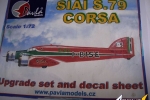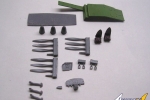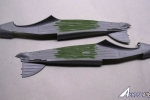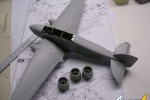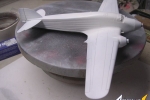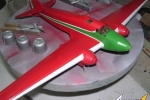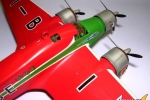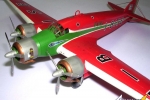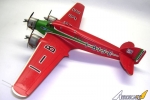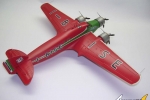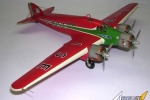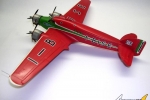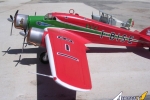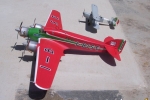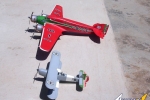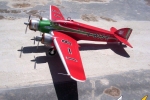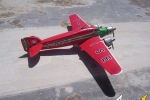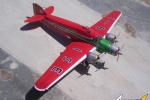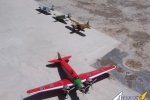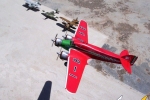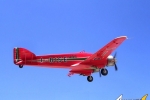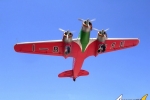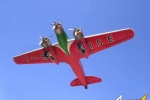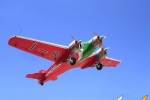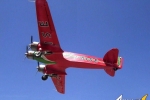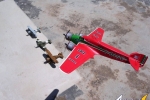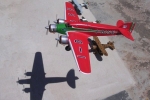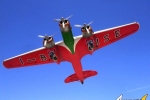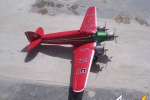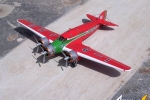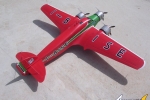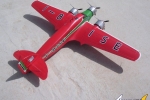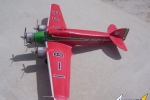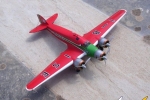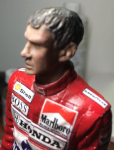1⁄72S.79 Corsa
4
Comments
History
The tri-motor S-79T was a long-range version of the S-79C with increased fuel capacity and Alfa Romeo 126 KC34 engines. Three S-79Cs were converted to S- 79Ts, the T standing for Trans Atlantic. These were prepared for a South Atlantic crossing on route where scheduled airline service was being planned.The identity of the three S-79Ts was as follows: MM359 I-BIMU became I-BISE, after pilot Attilio Biseo and Amadeo Paradisi MM358 I-CUDA became I-MONI and MM356 I-FILU became I-BRUN indicating each airplane commander. After detailed preparation, the three S-79Ts took off on January 1938 for record flight to Rio Di Janeiro, Brazil, via Dakar, Senegal, which was the route of many previous pioneering ocean flights.
The ‘Green Mice’ S-79T I-BISE, formerly I-5 I-BIMU had markings that are mixed with civil registration and I for Italy on the rudder and also the military shield on the white rudder stripe.
The three ‘Green Mice’ flew almost 10,000 Kilometres at an average speed of 248 mph, landing in Rio on the evening of 25th January 1938 with one S-79 being slowed down by propeller trouble. The flight was possibly the final act of the Golden Age of aviation prior to the outbreak of the Second World War. The last pioneering flight was further emphasised in the Italian media because of the presence of Bruno Mussolini. The 19-year-old Bruno was the Italian dictator Benito Mussolini’s son who later died in 1941testing a Piaggio P-108 bomber.
The three aircraft were later presented to the Brazil air service which serialled them K420, 421 and 422. In 1938 a standard S-79 bomber that was sent to Brazil to stimulate an order for Italian warplanes that did not materialize also joined them. The aircraft had limited activity due to lack of spares and support. They were struck off Brazilian charge in 1943/44.
The kit:
SIAI S.79 Corsa and Italeri kit No 1243Make: Pavlamodels.cz conversion resin parts
Scale: 1/72.
Decal: Two decal options
Type: Resin and decal set recommended for the Italeri or Airfix S79 bomber to convert into the S-79T Corsa.
Converting the Italeri S79 III Sparviero bomber into the S-79T could be carried out in the distant past using the Superscale decals that provides decals for any one of the three named above, and the extra work needed to convert the forward half of the fuselage is left for the modeller to do.
It has never been so good now that we have the Pavla Models upgrade set and decal sheet for such a conversion which besides a set of excellent complete decal sheet. There are also all the detail parts necessary for such a conversion including a clear upper fuselage front integrating the cockpit canopy, port holes and windows, resin seats, instrument panel, cabin floor, control wheels, rudder pedals, side door and complete 8 page detail instructions.
The conversion simply consisted of removing the cumbersome raised dorsal gunner turret and replaces it along with the vac form fuselage top section. This also replaces the bomber side gunner’s position. A continuation of the fine fuselage ripples was built up with a little filler and shaped to form continuous ripple detail at the lower fuselage in place of the various side windows, which have been blanked. Bracing wires were added to the tail fin and tail planes at each side. The following steps indicate the sequence one may follow to make the S-79T
- 1. Fix all clear windows to both fuselage halves and the door. These are blended with the conformity of fuselage fabric ripple skin form and shaped by sanding.
- 2. Close and seal bomb doors, fill and sand for smooth finish.
- 3. Remove two small knobs from cockpit top position, as there is no need for gun mountings.
- 4. Add small tabs at the fuselage opening along the sides so that these secure the clear Perspex part when it is correctly fixed in place.
- 5. Blank the interior bomb bay detail with a flat piece of plastic card to form continuation of the cabin floor.
- 6. Blank round windows under the nose.
- 7. A new side door is engraved to port fuselage half just aft of cockpit area.
- 8. Drill resin intake opening to go on fuselage and add D/F loop.
- 9. The rudder colour should be green at forward of rudder.
- 10.The propellers were replaced with the separate blades given in the Pavla set which came with a prop spinner., a complete set for all three engines.
Colour and markings
Decals in the Pavla set cater for either one with registration I-BISE or an alternative one of similar red overall and green trim finish S-79C MM358 with the race number I-II appearing on fuselage sides and top and bottom of wings.The fuselage interior was interior green while the outside was given a base coat in white and this was followed by Model Master gloss Guards red 27186. The rudder stripe decal was corrected with painting a stripe of emerald green to match the decal sheet shade of green. Engine cowlings were metal finish with the exhaust manifold in brass.
Conclusion
I do not mind building a ’between wars’ civilian type from time to time and there is history attached to this aircraft with the most colourful livery that made it all the more attractive when complete. I recommend this medium level conversion to anyone interested in the peaceful years era of aviation history.Comments
As a big fan of Italian design, these planes are just great.
So different, so typical.
Regards,
Robert Jan
JAN 24, 2014 - 12:26 PM
Excellent project, very well made and painted, overall impressive SM79! Gotta love the red machine
JAN 24, 2014 - 12:55 PM
A very impressive conversion. Your paint scheme and decaling is just amazing, not to mention near on perfect.
Joel
JAN 26, 2014 - 02:29 AM
Copyright ©2021 by Carmel John Attard. Images also by copyright holder unless otherwise noted. The views and opinions expressed herein are solely the views and opinions of the authors and/or contributors to this Web site and do not necessarily represent the views and/or opinions of AeroScale, KitMaker Network, or Silver Star Enterrpises. Images also by copyright holder unless otherwise noted. Opinions expressed are those of the author(s) and not necessarily those of AeroScale. All rights reserved. Originally published on: 2014-01-25 00:18:37. Unique Reads: 5878





